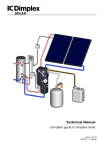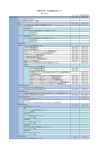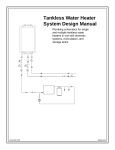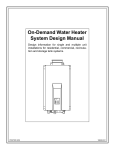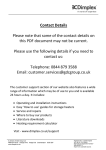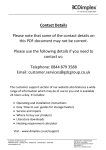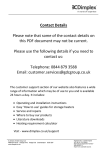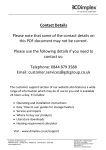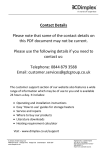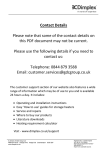Download Dimplex SCxn175d Operating instructions
Transcript
Contact Details Please note that some of the contact details on this PDF document may not be current. Please use the following details if you need to contact us: Telephone: 0844 879 3588 Email: [email protected] The customer support section of our website also features a wide range of information which may be of use to you and is available 24 hours a day. It includes: • Operating and installation instructions • Easy ‘How to use’ guides for storage heaters • Service and repairs • Where to buy our products • Literature downloads • Heating requirement calculator Visit ‐ www.dimplex.co.uk/support A division of GDC Group Ltd Millbrook House Grange Drive Hedge End Southampton SO30 2DF www.dimplex.co.uk Registered No: 1313016 England VAT GB 287 1315 50004 EEE Producer Registration Number – WEE/GE0057TS Paper from sustainable sources WATER Unvented hot water cylinder – SCxn…d/i, SCxn…sd/si Installation and operating instructions Page 1 of 28 ST0109 – C 05/09 Unvented hot water cylinder – SCxn…d/i, SCxn…sd/si WATER 0 Overall view Standard SCxn cylinder SCxn80/130/150/175/215/255/305d 04 01 02 07 SCxn80/130/150/175/215/255/305i 05 04 03 01 06 02 05 11 10 08 03 09 07 Figure 1 – Overall view of proposed installation sequence SCxn…d/i Page 2 of 28 ST0109 – C 05/09 Unvented hot water cylinder – SCxn…d/i, SCxn…sd/si WATER SCxn175/215/255/305sd Solar SCxn cylinder 18 01 02 04 16 07 17 05 SCxn175/215/255/305si 12 06 03 13 15 14 18 01 04 02 16 17 11 08 05 10 09 12 07 03 13 14 15 Figure 2 – Overall view of proposed installation sequence SCxn…sd/si Page 3 of 28 ST0109 – C 05/09 Unvented hot water cylinder – SCxn…d/i, SCxn…sd/si WATER 1 Contents 0 OVERALL VIEW 2 1 CONTENTS 4 2 BEFORE YOU START 5 GENERAL COMPETENCE HEALTH AND SAFETY RISK ASSESSMENT 5 5 5 6 3 SCOPE OF DELIVERY 6 4 PRODUCT FEATURES AND DESCRIPTIONS 7 5 INSTALLATION 9 5.1 GENERAL ADVICE 5.2 SITING CONSIDERATIONS 5.3 COLD WATER SUPPLY AND DISCHARGE PIPE WORK 5.4 HOT WATER OUTLET 5.5 IMMERSION HEATER 5.6 INDIRECT HEATING LOOP 5.7 SOLAR LOOP 5.8 SECONDARY RETURN 5.10 INSTALLATION EXPANSION VESSEL 5.11 WIRING SCHEMATIC AUXILIARY LOOP 5.12 WIRING SCHEMATIC SOLAR LOOP 5.13 SOLAR SENSOR INSTALLATION 6 COMMISSIONING 6.1 SCXN … D/I RANGE 6.2 SCXN … SD/SI RANGE 7 OPERATION 7.1 WATER TEMPERATURE DIRECT ELECTRIC HEATING 7.2 WATER TEMPERATURE AUXILIARY HEATING 9 10 10 12 12 13 14 15 15 16 19 19 21 21 21 22 22 23 8 MAINTENANCE 23 9 TROUBLESHOOTING 24 10 TECHNICAL DATA 25 10.1 SCXN … D/I 10.2 SCXN … SD/SI 25 26 Page 4 of 28 ST0109 – C 05/09 Unvented hot water cylinder – SCxn…d/i, SCxn…sd/si WATER 2 Before you start General Thank you for choosing a Dimplex product. We ensure you that every effort was made at design, manufacture and delivery stages of this product to meet your expectations. We ensure you of our best possible support throughout the product’s lifespan. As part of ongoing product development and improvement Dimplex reserves the right to undertake changes to the product without prior notice. Great care has been taken to ensure this manual was correct at the time of print. Should you however discover any issues with the information contained therein please do not hesitate to contact your vendor. We strongly recommend you read the whole contents of this manual before commencing the work. Competence Dimplex products have been designed and manufactured to the current relevant standards and under stringent quality control. It is therefore imperative that the product is only installed by a: - trained and - competent person as defined in the relevant regulations. Dimplex does not accept any liability for damage done to persons or property resulting from undue handling and usage of this product. All regulations current at the time of installation are to be considered alongside the content of this manual as they form the code of best practice. The guarantee of this product is linked to the ability of proving that the product was installed, commissioned and maintained: - by a competent person - in accordance with Dimplex instructions and the current relevant regulations and legislation - the product being registered with Dimplex at the time of installation using the form in the Dimplex On Site Guide - records showing the date of maintenance in accordance with the maintenance schedule as detailed in the On Site Guide Health and Safety The installation of this product is subject to the Health and Safety at Work Act. It is your responsibility to ensure that the transport, storage, installation and operation of the product is carried out in a safe manner. Dimplex will not accept any liability due to damage caused to people or property resulting from negligence or not adhering to the relevant Health and Safety practises. Page 5 of 28 ST0109 – C 05/09 Unvented hot water cylinder – SCxn…d/i, SCxn…sd/si WATER Risk assessment The compilation of a risk assessment is strongly recommended before installing the product. The following areas require particular consideration in addition to the information required by the Health and Safety at Work Act. - scalding: where appropriate or required by law a thermostatic mixing valve is to be fitted to the hot water outlet of the cylinder - explosion: the unit is fully equipped with all relevant safety equipment to comply with current regulations. The correct design and function has been verified by independent third party testing. The correct application thereof is the responsibility of the competent installer. - water borne organisms (i.e. Legionella): if applicable a risk assessment should be carried out following the recommendations outlined in the Approved Code of Practise L8. - the user preference must be considered when commissioning the system, in particular when adjusting the solar and auxiliary system temperature and timer settings. 3 Scope of delivery Please check the contents and condition of your delivery before signing the delivery documentation. Contact your supplier immediately for any missing or damaged components. Claims for missing or damaged parts after signing for the delivery will not be accepted. SCxn 80/150/175/215/255/305 d SCxn 175/215/255/305 i sd si x1 x1 x1 x1 x1 x1 x1 x1 x2 x1 x1 x1 x2 x1 x1 x1 x2 x1 x1 x1 x2 x1 x1 Unvented stainless steel cylinder including: - cold water inlet hot water outlet ½” sensor pockets ½” secondary return auxiliary heating coil solar coil twin thermostat 3kW immersion T&P Valve x1 x1 x1(SCxn80)/x2 x1 Page 6 of 28 ST0109 – C 05/09 Unvented hot water cylinder – SCxn…d/i, SCxn…sd/si WATER SCxn…d Expansion vessel: 18 l: 175 l, 215 l 24 l: 255 l, 305 l SCxn…i SCxn…sd SCxn…si - - x1 x1 - - x1 x1 2bar 6bar 2bar 6bar 3bar 6bar 3bar 6bar x1 x1 x1 x1 - x1 - x1 Instructions x1 x1 x1 x1 Benchmark card x1 x1 x1 x1 Expansion vessel fixing kit Inlet control group Tundish 15mm – 22mm Two port motorised valve 22mm Pres. red. Pres. rel. Figure 3 – Scope of delivery 4 Product features and descriptions The Dimplex® unvented stainless steel cylinder range incorporates many features to ensure the highest level of comfort in providing hot water while minimising energy requirements and environmental impact during manufacturing, operation and disposal. The range covers storage volumes from 80 litres to 305 litres in various designs from direct electric heated units, indirect units to a range of units allowing the use of renewable energy sources such as solar thermal. A complete list of features provided by the whole range of cylinders is given in Figure 4. Page 7 of 28 ST0109 – C 05/09 Unvented hot water cylinder – SCxn…d/i, SCxn…sd/si WATER SCxn d Feature Materials - inner cylinder - outer cylinder - inlet/outlet - coils - insulation Maximum operating conditions - potable water temperature - heating water temperature - operating pressure Cold water supply - minimum dynamic pressure - maximum pressure - minimum flow rate Connections - cold water inlet - hot water outlet - secondary return - coil flow and return - sensor pocket Coil specification - surface area [m²] - rating [kW] Immersion heater Thermostatic control - direct input - indirect input Safety components - pressure reducing valve and strainer - expansion relief valve - temperature and pressure relief valve - factory pressure test Other features Approvals Guarantee - inner cylinder - immersion heaters - other components 80 305 i 80 130 150 175 215 255 305 si sd 175 305 175 305 Duplex stainless steel Dove grey leather grain coated steel Stainless steel Corrugated stainless steel 60mm PU foam (GWP=1, ODP=0) 70°C 95°C 6bar 1.5bar 25bar 15 l/min 22mm stainless steel 22mm stainless steel ½”F BSP 22mm stainless steel ½”F BSP 1/ 2 0.3 7 0.5 14 0.75 17 0.75/1.1 17/- 1 1 2 - integral immersion heater thermostat and cut out - external twin thermostat and cut out 2bar 3bar 6bar 7bar / 90°C 6bar 7bar / 90°C 10bar 10bar Water inlet diffuser – prevents cold and hot water from mixing Water outlet sloped – improves stratification during draw off and reduces heat loss Light weight – easy handling No anode – reduced service requirements KIWA BBA 25 years 2 years – excluding the effects of lime scale 5 years – excluding expansion vessel membrane pressure Figure 4 – Product features Page 8 of 28 ST0109 – C 05/09 Unvented hot water cylinder – SCxn…d/i, SCxn…sd/si WATER 5 Installation 5.1 General advice Please read the following section carefully before commencing installation. If in any doubt, please call the appropriate help desk. Disregarding the instructions given in this manual in its entirety and any relevant regulations, standards and codes of practice will void the guarantee of this product. Please note: the following instructions are structured in such a way that individual steps are described. Not all steps will apply to all products. Figure 5 shows which steps apply to which cylinder types. Figure 5 – Chapter reference Handling – depending on the size of the unit and access to its installation location consideration must be given to the handling of the unit. Please note that handling, installation and use of this product is subject to the Health and Safety at Work Act. If the unit is not installed immediately, it should remain in its protective packaging with all pipe protectors/end caps applied to prevent damage and dirt deposit inside the cylinder and the coils. Pipe work – the pipe runs should be executed as short as possible, unused pipe work should be removed and all remaining pipe work should be lagged in accordance with regulatory requirements to prevent heat loss and the formation of condensation. Taps and fittings – all taps and fittings incorporated in the unvented system should have a rated operating pressure of 6 bar or above. Page 9 of 28 ST0109 – C 05/09 Unvented hot water cylinder – SCxn…d/i, SCxn…sd/si WATER 5.2 Siting considerations When choosing a suitable location for the cylinder the following aspects should be considered: - structural integrity - access for installation, operation, maintenance and replacement - routing of discharge pipe work - access to water mains supply, hot and cold water distribution pipe work - access to suitable electricity supply - location in relation to remaining system components such as auxiliary and solar heating system - frost protection The Dimplex SCxn cylinder range is designed to be floor standing, vertically mounted, indoors and in a frost free environment. The cylinder may be located on any flat and level surface, provided it is sufficiently robust to support the weight of the cylinder when full of water (see chapter 10). The position and orientation of the cylinder should be such that easy access is provided for servicing the controls and replacing the immersion heater should the need arise. Ensure that no pipe work hinders any work to be carried out on the various cylinder components. Particular care must be taken when placing the cylinder in a garage or outbuilding. All exposed pipe work must be correctly insulated to avoid frost damage. If required the occurrence of frost has to be avoided by means of heating the space in which the cylinder is located. 5.3 Cold water supply and discharge pipe work The required operating conditions of the Dimplex SCxn cylinder range are summarised in Figure 4. The following instructions have to be followed when installing the cold water mains supply to the cylinder. 1 2 3 4 The cold water supply to the cylinder must come directly from the cold water mains after the mains stop valve to the property. The inlet group supplied with the cylinder contains a line strainer, pressure reducing valve, pressure relief valve, check valves, balanced cold water supply port and a connection point for the expansion vessel (required for SCxn solar only). The cold water inlet pipe work should have at least an inside diameter of 19mm and meeting the requirements of the water regulations for the supply of wholesome water. The discharge pipe work from the expansion relief valve must be installed constantly falling to an open point of discharge. It is recommended to combine it with the discharge of the temperature and pressure relief valve as illustrated in Figure 6. When completing the installation of the discharge pipe work ensure the valve itself is secured by tightening the screw on the side of the assembly. Loosening the screw allows the best possible orientation of the valve. Page 10 of 28 ST0109 – C 05/09 Unvented hot water cylinder – SCxn…d/i, SCxn…sd/si WATER 5 6 It is recommended to install a drain valve in the lowest point of the cold water feed to the cylinder. This allows the cylinder to be drained in a controlled manner should this become necessary. Note: Between the inlet group and the cold water inlet on the cylinder NO isolating device should be fitted as by doing so important safety devices could be isolated! The temperature and pressure relief valve must be discharged into the tundish. The sizing of the discharge pipe work is regulated through building regulation G3. An extract is shown in Figure 6. 01 max. 500mm 02 06 03 min. 300mm Discharge pipe constantly falling to safe discharge location. 05 04 Page 11 of 28 ST0109 – C 05/09 Unvented hot water cylinder – SCxn…d/i, SCxn…sd/si WATER Figure 6 – Cold water supply and discharge pipe work installation 5.4 Hot water outlet The hot water pipe work is to be directly connected to the how water outlet connections of the cylinder as indicated in Figures 1 and 2. Should a thermostatic mixing valve be required the valve is to be installed following the manufacturers instructions. When fitting the thermostatic mixing valve ensure that none of the safety relevant devices of the unit can be isolated (see 5.3). It is recommended to insulate the hot water pipe work from the cylinder to the outlets to reduce the energy requirements for providing hot water. 5.5 Immersion heater The immersion heater has to be connected in accordance with IEE Wiring Regulations and the installer carrying out the work has to be suitably qualified. It must be connected through a double pole isolating switch or suitable controller which must have a contact separation of at least 3mm in all poles. The wiring diagram for the immersion heater is shown in Figure 7. For further details please see instructions provided with immersion heater. The immersion heater incorporates an independent non-self resetting over temperature cut-out. Should the over temperature cut-out operate, the rest pin will be pushed upwards, and become level or slightly proud of the cover at the position marked “Safety”. Use a suitable sized implement to reset the pin by pushing it hard into its original position. Figure 7 – Wiring diagram immersion heater Page 12 of 28 ST0109 – C 05/09 Unvented hot water cylinder – SCxn…d/i, SCxn…sd/si WATER Note: The cylinder must be filled with water before switching on the immersion heater. Failure to do so will damage the element and void any guarantee on the product. 5.6 Indirect heating loop The indirect heating source can be connected to the cylinder in various ways as described by the chosen control system supplier. The wiring and installation principles for two typical integration methods are detailed in chapter 5.11. SCxn…i 08 10 11 09 SCxn…si 11 08 10 09 Figure 8 – indirect heating loop installation To conform with building regulations it is imperative that the motorised two port valve is installed in the indirect heating loop and connected into the control circuit as required. Page 13 of 28 ST0109 – C 05/09 Unvented hot water cylinder – SCxn…d/i, SCxn…sd/si WATER The port connections for the indirect heating flow and return are identified in Figure 1 for the SCxn…i range and in Figure 2 for the SCxn…si range. Should the flow connection be the highest point in the indirect heating loop an adequate device for de-aeration has to be installed. Equally, should the return connection be the lowest point in the indirect heating loop, a suitable drain device should be installed in the lowest point. When installing the motorised two port valve ensure the direction of flow is adhered to as marked on the body of the device. Connecting the control loop ensure the correct thermostat on the cylinder is chosen for the respective loop. The fittings used to connect to the cylinder must be suitable for stainless steel. Not all push fit fittings can be used – please check with your supplier. Should compression fittings be used ensure that the connection is not being over-tightened, always countering the force with a second spanner. 5.7 Solar loop The solar loop has to be completely installed: - in metal pipe work - insulated with high temperature insulation - connected with compression fittings only (or other means which are suitable for solar) SCxn…sd / SCxn…si 12 14 13 Figure 9 – Solar loop installation Page 14 of 28 ST0109 – C 05/09 Unvented hot water cylinder – SCxn…d/i, SCxn…sd/si WATER The wiring schematic for the solar loop is detailed in chapter 5.12. Please note: the solar loop does not require a motorised two port valve as long as: - the Dimplex SOLPU1/2 pump unit is being used (non return valves in flow and return) - the cylinder is located lower than the solar panels - all other connection requirements in this manual are being adhered to To conform with building regulations it is imperative that the solar circulation pump is installed in the solar loop through the twin thermostat and not directly from the solar control unit. The port connections for the solar flow and return connections are identified in Figure 2 for the SCxn…sd and the SCxn…si range. Should the flow connection be the highest point in the solar loop an adequate device for de-aeration has to be installed should the system not be commissioned using a flush a fill pump. Equally, should the return connection be the lowest point in the solar loop, a suitable drain device should be installed in the lowest point. 5.8 Secondary return A ½” boss is provided on the SCxn…sd/si cylinder range to connect a secondary return loop to avoid: - stagnant water in long pipe runs - long waiting times at draw off point for hot water - undue water wastage To minimise the energy consumption of the secondary return circuit and to ensure reliable operation it is important to consider: - the control of the circulation pump to be time and temperature controlled - the secondary return circuit pipe work to be insulated - the secondary return pump to be of suitable material The location of the secondary return connection on the cylinder is highlighted in Figure 2. 5.10 Installation expansion vessel Optional for standard SCxn d/i cylinders, mandatory for solar SCxn d/I cylinders. The expansion vessel can be connected directly to the cold water inlet group utilising the flexible hose supplied with the vessel. It is important not to install any isolating devices between the vessel and the cold water inlet group. Further it is recommended to mount the vessel higher than the cylinder to avoid having to drain the cylinder when maintaining and replacing the expansion vessel. The connection of the expansion vessel to the inlet group is shown in Figure 10. Page 15 of 28 ST0109 – C 05/09 Unvented hot water cylinder – SCxn…d/i, SCxn…sd/si WATER Figure 10 – Installation expansion vessel (optional for standard SCxn d/i cylinders, mandatory for solar SCxn d/I cylinders) It is important to check the pre-charge pressure of the expansion vessel membrane before filling the cylinder. The pre-charge should be >2bar. 5.11 Wiring schematic auxiliary loop The auxiliary heating system can be interfaced with the Dimplex SCxn cylinder in various. Two common examples are given in Figures 11 and 12. Before adapting one of the proposed systems ensure the system is compatible with the remaining control equipment installed in the system. Page 16 of 28 ST0109 – C 05/09 Unvented hot water cylinder – SCxn…d/i, SCxn…sd/si WATER Figure 11 – Auxiliary loop integration 2x motorised two port valve Page 17 of 28 ST0109 – C 05/09 Unvented hot water cylinder – SCxn…d/i, SCxn…sd/si WATER Figure 12 - Auxiliary loop integration 1x motorised two port valve and mid-position valve Page 18 of 28 ST0109 – C 05/09 Unvented hot water cylinder – SCxn…d/i, SCxn…sd/si WATER 5.12 Wiring schematic solar loop The integration of the Dimplex solar SCxn cylinder is shown in Figures 11 and 12. The wiring schematic for the solar loop is shown in Figure 13. Figure 13 – Solar loop integration 5.13 Solar sensor installation The Dimplex solar SCxn range cylinders allow for the installation of two sensors. The lower sensor is required to control the solar circulation pump. The upper sensor is for information only to indicate the actual available hot water temperature. Two ½” sensor pockets are supplied with the pump unit. The sensor pockets are to be used to install the sensors in the cylinders. The location of the sensor bosses is indicated in Figure 14, also showing the methodology of installing the sensor into the sensor pocket. A suitable sealant is to be used such as Loctite 577. Page 19 of 28 ST0109 – C 05/09 Unvented hot water cylinder – SCxn…d/i, SCxn…sd/si WATER 03 01 02 Figure 14 – Solar sensor boss positions and sensor installation Page 20 of 28 ST0109 – C 05/09 Unvented hot water cylinder – SCxn…d/i, SCxn…sd/si WATER 6 Commissioning The following commissioning procedure only details the required steps to be taken for the potable water loop and not for the direct heating, auxiliary or solar loops. Please refer to relevant manuals for these operations. 6.1 SCxn … d/i range 1 2 3 4 5 6 7 8 9 10 11 12 13 14 15 16 17 Check all connections and joints to ensure they have been tightened and secured correctly. Before turning on the mains supply to the cylinder a hot water tap should be opened, preferable on the same floor or the floor below where the cylinder is located. Turn on the supply to the cylinder and fill until water runs from the open hot water tap. Turn off the mains supply to the cylinder and wait for the water to stop running from the hot water tap. Operate the temperature and pressure relief valve until water stops flowing. Close the hot water tap and temperature and pressure relief valve. Connect an air pump to the Schrader valve (valve with blue cap) located on the pressure reducing valve (inlet group). Pump air into the Schrader valve until a pressure of 1 bar is reached. Remove the pump and replace the blue cap. Turn the mains supply back on and bring the cylinder up to working pressure. Check all joints for leaks, even those not having been altered especially when replacing a vented cylinder. Open temperature and pressure relief valve to ensure proper discharge and check after closing that valve is not dripping. Open pressure relief valve to ensure proper discharge and check after closing that valve is not dripping. Check all shower outlets, toilet cisterns and other draw off points for leaks or dripping (especially when replacing a vented unit). Open all water outlets to purge air from pipe work and ensure proper operation. Adjust timer programmer and cylinder thermostat settings in accordance with client requirements. Instruct user in the operation of the unit and hand over manuals and benchmark card, advising the owner of annual service requirement. 6.2 SCxn … sd/si range 1 2 3 Check all connections and joints to ensure they have been tightened and secured correctly. Before turning on the mains supply to the cylinder a hot water tap should be opened, preferable on the same floor or the floor below where the cylinder is located. Check the pre-charge in the expansion vessel and ensure it is at least 2bar. Note actual pressure on label on expansion vessel. Page 21 of 28 ST0109 – C 05/09 Unvented hot water cylinder – SCxn…d/i, SCxn…sd/si WATER 4 5 6 7 8 9 10 11 12 Turn on the supply to the cylinder and fill until water runs from the open hot water tap. Close the hot water tap. Check all joints for leaks, even those not having been altered especially when replacing a vented cylinder. Open temperature and pressure relief valve to ensure proper discharge and check after closing that valve is not dripping. Open pressure relief valve to ensure proper discharge and check after closing that valve is not dripping. Check all shower outlets, toiler cisterns and other draw off points for leaks or dripping (especially when replacing a vented unit). Open all water outlets to purge air from pipe work and ensure proper operation. Adjust timer programmer and cylinder thermostat settings in accordance with client requirements. Instruct user in the operation of the unit and hand over manuals and benchmark card, advising the owner of annual service requirement. 7 Operation Once the system has been fully commissioned, no user interference should be required to fully enjoy the comfort and benefits of the Dimplex SCxn hot water cylinder. The hot water temperature can be set to various requirements. Ideally it should be around 60°C. Higher temperature can cause tripping of the high limit thermostat, introduces more heat loss from the unit and increases the risk of scalding significantly. When turning on a hot tap for the first time after a heat up period there might be a short surge of water. This is normal in unvented systems and does not constitute a fault. Sometimes the water may appear milky – this is due to very fine air bubbles in the water which will clear quickly. 7.1 Water temperature direct electric heating Before removing the cover from immersion heater isolate appliance on isolating switch! Danger of electrical shock! Never enter immersion heater housing with blank metal objects! Dial to adjust water temperature. Figure 15 – Adjustment water temperature direct electric heating element Page 22 of 28 ST0109 – C 05/09 Unvented hot water cylinder – SCxn…d/i, SCxn…sd/si WATER The hot water temperature achieved by the direct electric heating element can be adjusted by removing the cover from the immersion heater and adjusting the dial up or down as indicated in Figure 15. 7.2 Water temperature auxiliary heating The water temperature achieved by the auxiliary heating system depends on the setting of the thermostat on: - the cylinder AND - the auxiliary heating source. The adjustment at the cylinder is being carried out on the twin thermostat fitted to the cylinder as shown in Figure 16. The manual high limit re-set is behind the black screw. Dial to adjust water temperature. Figure 16 – Adjustment water temperature auxiliary source 8 Maintenance The maintenance of this appliance must be carried out by a suitably qualified person only. Isolate all electrical supplies from the unit before commencing work. Danger of electrical shock! 1 2 3 4 5 6 7 8 9 Draw some water from cold water tap and retain in container. Isolate cold water mains supply from cylinder. Briefly open temperature and pressure relief valve, assure safe discharge and check that valve is not dripping when closed. Briefly open pressure relief valve, assure safe discharge and check that valve is not dripping when closed. Open hot water tap and release remaining pressure from unit. Note the set pressure of pressure reducing valve. Remove cartridge and clean strainer in water provided in container. Re-assemble pressure reducing valve ensuring the correct pressure is set. Periodically the immersion heaters should be removed, cleaned and the unit flushed out. The immersion heater seal should be replaced when fitting the element to the cylinder. Check electrical wiring connections and the condition of the cable of the immersion heater and the thermostat. Re-commission unit. Page 23 of 28 ST0109 – C 05/09 Unvented hot water cylinder – SCxn…d/i, SCxn…sd/si WATER 9 Troubleshooting Fault A No water from hot water taps B No hot water Cause A.1 Stop valve closed A.2 Strainer blocked A.3 Pressure reducing valve fitted against flow B.1 Timer/Programmer not set correctly B.2 Auxiliary heating mal function B.3 Direct heating mal function C Intermittent water discharge through tundish on warm-up D Continuous discharge B.4 Auxiliary/direct heating high limit thermostat has tripped C.1 Bubble depleted C.2 Expansion vessel lost charge D.1 Pressure reducing valve not working D.2 Pressure relief or T&P valve not seating correctly E Leakage from casing F Hot water from cold tap G Metallic noise from system D.3 Mal function of high limit thermostat or appliance E.1 Compression/threaded joints not formed correctly F.1 Hot pipe work being routed adjacent to cold pipe work F.2 Leaking seal in mixer tap G.1 Pipe work not sufficiently supported Solution A.1 Open stop valve A.2 Turn water supply off, clean strainer and recommission A.3 Re-fit with arrow showing in direction of flow B.1 Set timer/programmer correctly B.2 Consult auxiliary heating system instructions B.3 Call for qualified person to check immersion heater B.4 Reset limit thermostat(s) C.1 See commissioning for creation of bubble C.2 Check expansion vessel (see commissioning/maintenance), top up or replace D.1 Check pressure after valve and replace if faulty D.2 Manually lift valve once or twice to clear debris, otherwise replace D.3 Check function of thermostats and appliances E.1 Re-seal joints with care F.1 Insulate hot pipe work or re-route F.2 Replace seals in mixer tap G.1 Add extra pipe work fixings Page 24 of 28 ST0109 – C 05/09 Unvented hot water cylinder – SCxn…d/i, SCxn…sd/si WATER 10 Technical data 10.1 SCxn … d/i F G [mm] H [mm] I [mm] d i SCxn 80 27 29 B B A Capacity Weight [kg] Heat loss [kWh] Heat up [mns] Re-heat [mns] A [mm] B [mm] C [mm] D [mm] E [mm] F [mm] A/I G H C D D E E F 130 30 32 150 32 35 175 37 40 215 43 48 255 50 55 305 59 65 d/i 1.12 1.50 1.82 2.10 2.59 2.73 2.88 d i d i d/i d/i d d/i d/i d/i 64 33 53 23 115 28 90 21 138 33 104 24 212 35 153 30 263 42 184 35 313 50 220 42 356 645 570 626 958 648 745 1086 167 27 124 24 182 196 753 891 1243 574 821 1116 1485 1269 1365 1753 1526 1620 2029 i i i 339 380 369 445 182 Page 25 of 28 ST0109 – C 05/09 Unvented hot water cylinder – SCxn…d/i, SCxn…sd/si WATER 10.2 SCxn … sd/si Capacity Weight [kg] Heat loss [kWh] Heat up [mns] Re-heat [mns] A [mm] B [mm] C [mm] D/N/P [mm] E [mm] F [mm] G [mm] H [mm] I [mm] J [mm] K [mm] L/0 [mm] M [mm] Aux. vol. [l] O J A L B K I G H M C P D/N E F SCxn 175 sd si sd/si sd si sd si sd/si sd/si sd sd/si sd/si sd/si si si si sd/si sd/si sd/si sd si sd si 44 48 1.78 20 18 14 13 215 255 52 56 2.19 24 22 17 18 305 59 63 2.31 29 25 20 19 69 73 2.51 34 30 24 22 1355 1527 1753 1631 1804 2029 1057 1029 170 160 1196 1167 220 210 182 531/589 846 1017 1243 1087 1259 1485 574 711 842 580 346 480 213 803 774 90 80 879 1116 130 120 Page 26 of 28 ST0109 – C 05/09 Unvented hot water cylinder – SCxn…d/i, SCxn…sd/si WATER Page 27 of 28 ST0109 – C 05/09 Unvented hot water cylinder – SCxn…d/i, SCxn…sd/si WATER Dimplex UK Limited Millbrook House Grange Drive, Hedge End, Southampton SO30 2DF Te.: 01489 773 052, Fax.: 01489 773 061 e-mail: [email protected] www.dimplex.co.uk Page 28 of 28 ST0109 – C 05/09





























